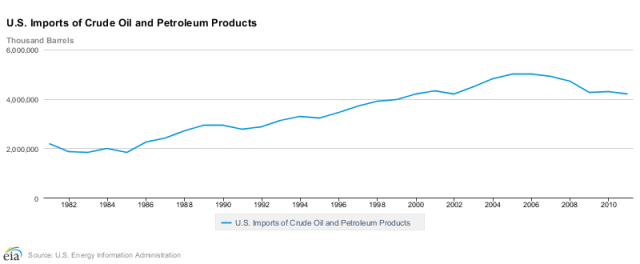FACT CHECK: Salazar Exaggerates Obama’s Record on Energy Production
Michael Sandoval /
Interior Secretary Ken Salazar touted President Obama’s record on reducing oil dependence in a speech delivered in Charlotte, NC, this week. Salazar pointed to a decrease in oil imports and an increase in oil production — especially on federal lands — as evidence of the efficacy of Obama’s policies.
But, contrary to Salazar’s timeline beginning “four years ago,” U.S. imports of crude oil and other petroleum products peaked in 2005 and began to decrease in 2006, and have flattened over the past three years, according to the Energy Information Administration.
See the chart below:
According to the EIA, beginning in 2005 several factors played a role in decreasing oil imports — most prominently, the contraction in the economy:
There is no single explanation for the decline in U.S. oil import dependence since 2005. Rather, the trend results from a variety of factors. Chief among those is a significant contraction in consumption. U.S. oil product deliveries declined by 1.7 million barrels per day (bbl/d) to 19.1 bbl/d in 2010, from 20.8 million bbl/d in 2005. This decline partly reflects the downturn in the underlying economy after the financial crisis of 2008. Not surprisingly, demand has bounced back somewhat from a low of 18.8 million bbl/d in 2009, when the U.S. economy bottomed out. But the downward trend in consumption started two years before the 2008 crisis and reflects factors such as changes in efficiency and consumer behavior as well as patterns of economic growth.
But even production increases on federal lands, such as those touted by Salazar as part of the reason for the reduced oil importing figures do not comport with the facts available, which show that oil production on federal lands has decreased between fiscal 2010 and fiscal 2011 by 11 percent. Natural gas production has decreased by 6 percent in the same one-year span. It is down nearly 27 percent from fiscal 2009. Meanwhile, oil and gas production have increased by 14 percent and 12 percent, respectively, on private and state-owned land.
Moreover, even as Salazar mocked a “drill, baby, drill” approach to domestic production, the EIA noted that it was increased production from drilling in “deepwater Gulf of Mexico and the Bakken formation [that] brought decades of contraction in domestic oil production to a sudden halt, and even led to a rebound.”
Yet the administration has remained resistant to projects like the Keystone XL pipeline. On an his watch, Salazar made the controversial decision to cancel 77 leases in Utah after they had already been sold at an auction in December 2008.
Salazar boasted that solar and wind energy had more than doubled since Obama took office, but EIA numbers from 2009 to 2011, the last full year available, show that the solar and wind contribution to the production of energy has only increased from 10.7 percent to 14.5 percent as a total of all renewable energy. When it comes to overall energy production from all sources, the share of solar and wind has increased from 1.1 percent to 1.7 percent.
Salazar, conversely, promoted the opening of federal lands to solar and wind development. But most of that development has occurred because of extensive Department of Energy loans and grants to companies that have gone bankrupt or are in dire financial straits — high-profile “setbacks,” according to Salazar. Still, Salazar’s focus on opening up large tracts of federal land to wind and solar projects has met opposition from environmental groups, and the promised capacity to generate energy for the three million homes routinely fails to even approach installed ratings, such as wind production in Texas, despite record government subsidies.
The administration, through legislation like the American Recovery and Reinvestment Act, hoped to stimulate “green job” creation. But again and again, those vaunted “green jobs” training programs failed to deliver anywhere near the number of jobs promised. At the state level, training programs for green-energy projects acknowledged that the demand simply had not materialized. Meanwhile, the administration attempted to paper over the deficit in green jobs by creatively aggregating newer jobs in the renewable energy field with older, preexisting “green jobs” to provide a rosier outlook.
Salazar praised the efforts of the administration to help the auto industry make “cars that Americans want to buy.” But Americans aren’t that enamored of vehicles like the Chevy Volt, which has experienced a series of production shutdowns and is expected to fail to meet sales targets again in 2012, despite thousands of dollars in federal incentives.


